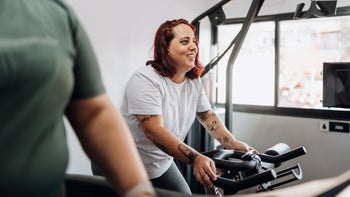
5 Isometric Exercises to Build Muscle Endurance
Key takeaways:
During isometric exercises, your muscles contract without moving.
Planks, wall sits, and bridges are examples of isometric exercises.
Isometric exercises can increase muscular endurance and functional strength for better health and fitness.

Is it possible to improve your fitness without moving a muscle? Technically, yes. Don't worry, we're not recommending a fitness trend that's too good to be true. We're actually talking about isometric exercises. These static exercises make your muscles contract without moving. They can help you build functional strength and boost your heart health.
Learn beginner-friendly isometric exercises to help you prepare for more advanced strength-training workouts.
What are the best isometric exercises for beginners?
An isometric exercise is a static movement where your muscles contract without changing length.
Search and compare options
Many go-to strength-training moves involve eccentric and concentric muscle contractions. Take the chest press, for example. When you lift the weights, your pectoral muscles shorten as they contract (concentric). As you lower the weights, your muscles lengthen as they contract (eccentric).
But with isometric muscle contractions, you hold a position to create tension in a muscle instead of moving. There are a variety of isometric exercises to target your core, upper, and lower body. You can add them to resistance workouts to help build a well-rounded strength-training routine.
Here are 5 isometric exercises for beginners.
1. Wall sit
The wall sit is a great way to target lower-body muscles. The static hold engages the quadriceps at the front of your thighs, hamstrings at the back of your thighs, and your glutes.
Step 1: Stand with your back against a wall and your feet about 2 feet in front of you.
Step 2: Engage your core as you slide down the wall into a squat. Keep your back flat against the wall with your knees bent at a 90-degree angle and your thighs parallel to the floor.
Step 3: Hold for 10 to 15 seconds before you slide up the wall and return to standing. You can increase the length of the hold as you get stronger.
2. Forearm plank
The forearm plank is a classic full-body isometric exercise. The core-strengthener mainly works the abs. But it also activates muscles in your chest, back, and legs.
Step 1: Start on the floor in a modified plank position by supporting your weight on your forearms. Your shoulders should be directly over your elbows with your forearms and palms flat on the floor. Your toes should be slightly curled under while touching the floor.
Step 2: Draw your belly button toward your spine to keep your core tight, and make sure your hips are aligned with your body. You want your body to stay in a straight line from your head to your heels. Squeeze your glutes to relieve the strain on your lower back.
Step 3: Hold the forearm plank for 10 to 30 seconds, then relax. You can increase the hold and add reps gradually.
Read more like this
Explore these related articles, suggested for readers like you.
3. Triceps dip hold
Not surprisingly, the triceps dip hold recruits the triceps muscles in the back of your upper arms. It also gives your chest and shoulder muscles a workout.
Bodyweight dips are often performed on parallel bars, but this position is generally too difficult for beginners. To keep it beginner-friendly, you will do this exercise with a chair or bench.
Step 1: Sit at the edge of a stable chair with your knees bent and feet flat about hip-width apart. As you build strength, you will start this move on your heels with your toes pointing toward the ceiling.
Step 2: Place your hands on either side of your hips, gripping the seat of the chair. Then, step your feet forward far enough to slide your bottom off the chair. Your butt will be just in front of the seat of the chair with your thighs parallel to the floor.
Step 3: Maintain your grip on the chair and bend your elbows as you lower toward the floor.
Step 4: Stop midway down and hold for 10 to 30 seconds. You can play around with how far down you dip. This will vary the exercise intensity and which triceps muscles you target.
Step 5: Press through your hands to push up and return to the starting position.
4. Wall push-up
The wall push-up activates muscles such as the triceps, pectorals, and latissimus dorsi in your upper back. It can help you learn how to do traditional and more advanced push-ups.
Step 1: Stand about an arm's length away from a wall. Extend your arms at shoulder level and place your palms on the wall. Your hands should be a few inches wider than shoulder-width apart. And your body should form a diagonal 45-degree angle with the wall.
Step 2: Bend your elbows as you move your chest towards the wall as if performing a standard push-up. Stop when your elbows are bent at a 90-degree angle and your face is close to the wall.
Step 3: Hold the position for 15 to 30 seconds. Squeeze your abs and glutes to engage your core and keep your spine straight.
Step 4: Extend your arms as you push away from the wall and return to the starting position.
5. Glute bridge
You might think the glute bridge only works the powerful hip extensors in your butt. But it also activates the abs and hamstrings.
Step 1: Lie on your back with your knees bent and your feet flat about hip-distance apart.
Step 2: Place your arms at your sides or cross them over your chest.
Step 3: Press your lower back to the floor and squeeze your abdominals to engage your core.
Step 4: Push through your heels and squeeze your glutes to lift your hips off the floor. At the top of the bridge, your body should form a straight line from your shoulders to your knees.
Step 5: Keep your core engaged and hold the bridge for 10 to 30 seconds.
Step 6: Slowly lower your hips to the floor.
What are the benefits of isometric exercises?
There are a number of benefits of isometric exercises for beginners, advanced athletes, and everyone in between. These top advantages might earn them a spot in your next strength-training workout.
Build muscle endurance and functional strength
Some research suggests that isometric contractions are less effective at building muscle mass than concentric and eccentric contractions. So, you won't necessarily build huge muscles with isometric exercises. But they may still support limited muscle growth. And they're great for building muscular endurance and functional strength.
Static exercises have been shown to build muscular endurance. Muscular endurance allows your muscles to contract and produce force for extended periods without tiring.
This type of endurance is helpful for any exercise — such as running, cycling, or lifting weights — that involves repetitive movement. It's also useful for daily activities like carrying a child, picking up grocery bags, or maintaining good posture while sitting at a desk.
Support pain relief and recovery after injury or surgery
Many physical therapists include low-impact isometric exercises in rehabilitation programs after musculoskeletal injuries or surgeries. They target muscle groups while limiting muscle and joint movement.
You can work the affected muscles without overdoing it or further injuring yourself. And for some injuries, such as knee pain, isometric holds may even ease pain because the muscles don't repeatedly shorten or lengthen. But, talk to your healthcare provider first if you're recovering from an injury or surgery.
Lower blood pressure
Cardio moves aren't the only exercises that are good for your heart. Ongoing research suggests that isometric training may help lower your blood pressure.
In a recent study, researchers compared different exercises, including:
Isometrics
Aerobics
Dynamic strength training
They found that isometric exercises, such as wall sits, were the most effective for lowering blood pressure.
Build mind-body awareness
Practicing isometrics can improve your mind-body awareness, which is particularly useful for beginners.
You continuously engage specific muscle groups while holding an isometric contraction. Doing so may help you become more mindful about your body and how to activate your muscles efficiently. Then, when you progress to more dynamic strength training exercises, you might have better form.
How to add isometric exercises to your routine
Isometric exercises can help beginners build a foundation for other strength-training moves. When you're ready to practice, these tips can help you get started.
Figure out your form. You can use a mirror to check your form while doing isometric exercises. Proper form is key to preventing injuries and getting the most out of each hold.
Remember to breathe. You might forget to breathe during isometric holds. But you should breathe normally during your workout. Do not hold your breath because it might make you dizzy.
Add a few isometric exercises to strength-training workouts. There are several isometric exercise benefits. But dynamic resistance exercises — such as walking lunges or bench presses — should still be the main focus of your strength-training workouts. Try adding a few static moves at the end of your training to challenge your muscular endurance.
Increase isometric exercise holds gradually. Work your way up to longer isometric holds as you get stronger. And make sure that you are prioritizing form over exercise duration. You should stop any move if your form starts to break down.
The bottom line
Isometric exercises involve holding a static position without moving. They can help you build muscular endurance and functional strength for daily activities and workouts. Beginner isometric exercises may also increase your body awareness as you prepare for more challenging strength training.
Why trust our experts?



References
American Council on Exercise. (n.d.). Chest press.
Earn That Body. (2016). How to do a tricep dip static hold [Video]. YouTube.
Edwards, J. J., et al. (2023). Exercise training and resting blood pressure: A large-scale pairwise and network meta-analysis of randomised controlled trials. British Journal of Sports Medicine.
Edwards, J. J., et al. (2023). The effect of isometric exercise training on arterial stiffness: A randomized crossover controlled study. Physiological Reports.
Fitness Blender. (2011). Wall sit [Video]. YouTube.
Hody, S., et al. (2019). Eccentric muscle contractions: Risks and benefits. Frontiers in Physiology.
Manske, R. C., et al. (2007). Muscle weakness. Physical Rehabilitation.
Oranchuk, D. J., et al. (2018). Isometric training and long-term adaptations: Effects of muscle length, intensity, and intent: A systematic review. Scandinavian Journal of Medicine and Science in Sports.
Physique 57. (2016). How to do a forearm plank [Video]. YouTube.
Rio, E., et al. (2017). Isometric contractions are more analgesic than isotonic contractions for patellar tendon pain: An in-season randomized clinical trial. Clinical Journal of Sport Medicine.
Schoenfeld, B. J., et al. (2017). Hypertrophic effects of concentric vs. eccentric muscle actions: A systematic review and meta-analysis. Journal of Strength and Conditioning Research.




























